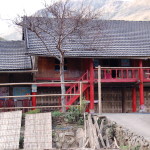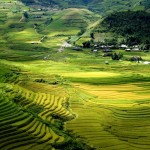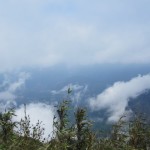Cu Chi tunnels travel guide and information
The article about Cu Chi and the tunnels by Sapa Travel
Cu Chi is about 40 km northwest of Ho Chi Minh City in Southern Vietnam. The Cu Chi Tunnels are an elaborate underground community made up of 250 km of tunnels and chambers below the city. The tunnels were dug with simple tools and bare hands during the French occupation in the 1940s, and further expanded during the Vietnam War in the 1960s to provide refuge and a defensive advantage over the American soldiers. Despite all the bombings in their town, the Cu Chi people were able to continue their lives beneath the soil, where they slept, ate, planned attacks, healed their sick, and taught their young. Some even wed and gave birth underground, but over 10,000 lost their lives here.
How to get there
A multitude of tour buses leave Ho Chi Minh City for the Cu Chi tunnels daily. Expect to pay around US$5 for a half day guided trip (not including admission to the tunnels), with 90 minutes travel and about an hour and a half touring the area. Buses mostly leave around 8:00, so consider a private car if this isn’t suitable. Tour operators on Pham Ngu Lao will quote from $45-75 return by private car, or possibly lower — don’t be afraid to shop around.
If you’re making the trip independently, hop on bus 13 from the Ben Thanh bus station. The last stop on the route is Cu Chi. Bus fare is 7,000 VND, and the ride is about 1.5 hours. When you arrive at the Cu Chi bus station negotiate a motorbike driver for the 20-minute ride for around 100,000 VND return (pay attention as starting price could be 200,000 VND or more). It is also possible to take bus 79. Ask the driver for Cu Chi tunnels, the ride will last about 45 minutes and cost 5,000 VND. The bus will reach a T-junction with Ben Duoc on the left and Ben Dinh on the right. Get off at this point and walk on to Ben Dinh, or stay on the bus as it drives right pass the Ben Duoc entrance. Warning, the buses are sometimes very warm and crowded but manageable.
Admission to the tunnels is 90,000 VND as at Febuary 2013, which includes a guide who may or may not speak English well. While friendly, these guides may attempt to rush the tour or distance you from paid guides/groups — just indicate that you aren’t ready to move on yet and take your time if you feel you’re being rushed.
There are actually two locations frequented by tourists:
Ben Duoc This is further out from Ho Chi Minh and many local Vietnamese go there. Tour companies can organize a day tour on demand, but you would be better off hiring a motorbike. Entrance is 80,000 dong and a motorbike should cost about $1-2 per hour. The round trip is about 6 hours. A walking tour with tunnels and temple last about 1-2h. The tunnels feature enlarged tunnel segments for you to crawl through and demos of the sleeping, medical and command quarters underground. The ticket office also features two Mig’s. Some guides here are lethargic and speak little English, but have show improvements recently. There are many dioramas including a mock village. A starch lunch is served for which a donation box is provided. Bats are also present.
Ben Dinh This is the touristed tunnels and you’ll be in good company. Note that all the tunnel sections at this site have been specially created for tourists and were never part of the real network. Also note that bats can be found roosting in some of the tunnels, so if you get bitten or scratched by one find a hospital quickly as bats may carry rabies.
If you drive to Ben Dinh on your own you find the real coordinates to the tunnels here (as the coordinates shown on google maps are obviously wrong and there are very little signs directing to the tunnels)
What to see
If you visit this place, you will have the opportunity to experience to walk down the tunnels, and see the weapons Viet Cong used to against their enemy. This is an important historical site to visit outside of Ho Chi Minh City.
The 75-mile (121 km)-long complex of tunnels at Cu Chi has been preserved by the government of Vietnam, and turned into a war memorial park. The tunnels are a popular tourist attraction, and visitors are invited to crawl around in the safer parts of the tunnel system. Some tunnels have been made larger to accommodate the larger size of Western tourists, while low-power lights have been installed in several of them to make traveling through them easier and booby traps have been clearly marked. Underground conference rooms where campaigns such as the Tết Offensive were planned in 1968 have been restored, and visitors may enjoy a simple meal of food that Viet Cong fighters would have eaten.
Above-ground attractions include caged monkeys, vendors selling souvenirs, and a shooting range where visitors can fire a number of assault rifles, such as the M16 rifle or AK-47, as well as a light machine gun like the M60.
This is the site of the Cu Chi tunnels, one of the most famous battlegrounds of the Vietnam War. Today it is one of the country’s prime tourist attractions, part of a new industry of war tourism. Sometimes, these spots seem to be memorials to wartime propaganda as much to the war itself.
Following the man in green fatigues, the tourists arrive at an open-sided hut, where the women in black show them to their seats. There, on a big-screen television set, the Vietnam War plays on: B-52’s drop strings of bombs, villagers run for cover, communist guerrillas fight back.
The Cu Chi tunnels, a 75-mile-long underground maze where thousands of fighters and villagers could hide, are at the top of the list of tourist spots for Ho Chi Minh City, 45 miles to the southeast. Another is the city’s Museum of War Remnants, with its displays of captured weapons and its catalog of horrors, which only recently amended its name, with changing times, from the Museum of American War Crimes. If you visit this place, you will have the opportunity to experience to walk down the tunnels, and see the weapons Viet Cong used to against their enemy. This is an important historical site to visit outside of Ho Chi Minh City.
The 75-mile (121 km)-long complex of tunnels at Cu Chi has been preserved by the government of Vietnam, and turned into a war memorial park. The tunnels are a popular tourist attraction, and visitors are invited to crawl around in the safer parts of the tunnel system. Some tunnels have been made larger to accommodate the larger size of Western tourists, while low-power lights have been installed in several of them to make traveling through them easier and booby traps have been clearly marked. Underground conference rooms where campaigns such as the Tết Offensive were planned in 1968 have been restored, and visitors may enjoy a simple meal of food that Viet Cong fighters would have eaten.
Above-ground attractions include caged monkeys, vendors selling souvenirs, and a shooting range where visitors can fire a number of assault rifles, such as the M16 rifle or AK-47, as well as a light machine gun like the M60.
This is the site of the Cu Chi tunnels, one of the most famous battlegrounds of the Vietnam War. Today it is one of the country’s prime tourist attractions, part of a new industry of war tourism. Sometimes, these spots seem to be memorials to wartime propaganda as much to the war itself.
Following the man in green fatigues, the tourists arrive at an open-sided hut, where the women in black show them to their seats. There, on a big-screen television set, the Vietnam War plays on: B-52’s drop strings of bombs, villagers run for cover, communist guerrillas fight back.
The Cu Chi tunnels, a 75-mile-long underground maze where thousands of fighters and villagers could hide, are at the top of the list of tourist spots for Ho Chi Minh City, 45 miles to the southeast. Another is the city’s Museum of War Remnants, with its displays of captured weapons and its catalog of horrors, which only recently amended its name, with changing times, from the Museum of American War Crimes.
What to do
Fire Weapons – choose between the AK-47, M16,.30 Caliber Machine Gun, M60, M1 carbine, M1 Garand and Russian SKS. Great fun, if you can put from your mind what these “toys” were really designed for! As of May 2012, firing an AK-47 costs 35,000 dong per bullet.You do not have to go the Cu Chi tunnels in order to fire a gun, the range and tunnels are separate. It is located outside the Cu Chi complex, by walking it is 1.5 miles or take a motorbike.
Where to eat
There are a number of stalls selling food and drinks near the entrance. Mid-way around the walking track is a kiosk/restaurant selling drinks and food and ice-cream at reasonable prices, and at the end there are samples of traditional “Tapiaco (Asian Potato)” to try.
Where to stay
Mekong Ecolodge, Quarter 5, An Hoa Hamlet, Dong Hoa Hiep, ☎ +84 933 449 391 (info@mekonglodge.com). US$65.
You can also rent a room in any hotels in Ho Chi Minh city stay and visit Cu Chi tunnel in one day. After that you can return to the downtown and enjoy your night in the lively atmosphere.
Shopping
There are numerous souvenir shops at the end of the walking track. Given the location there is some focus on war memorabilia, as well as the traditional Vietnamese souvenirs found elsewhere.








